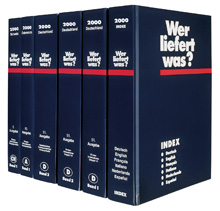who delivers what
"Who delivers what" is a database that describes itself as an online business-to-business platform (B2B). The company was founded in 1932 as an independent and cross-sector reference work for commercial buyers and today offers people who shop professionally or prepare purchasing decisions a free supplier search and product search on the Internet .
The enterprise
Since May 27, 2019, “Who delivers what” has been part of the “Visable” corporate brand, which also acts as a new employer for around 370 employees. The B2B platform will remain as a brand or offer from "Visable". The managing director of the new corporate brand is Peter F. Schmid, who was also managing director of “Wer hilft was” to date .
timeline
In 1932, the first book edition of “Who delivers what” came on the market. The Leipziger Messe was the publisher of the independent and cross-sector reference work for commercial buyers . The book edition appeared once a year and was published until 2000. In 1948, after the division of Germany, the “Who delivers was” publishing house was re-established in Hamburg. In 1970 the entire book was also published on microfilm . In 1986 a CD-ROM was published for the first time . Screen text was used to make the entered data accessible to users online . In 1990, in the course of the German reunification, the western and eastern editions of “Who delivers was” were merged in Hamburg. In 1995, “Who delivers what” appeared on the Internet. In 1996 the website was expanded to include a shop system . The advertisers thus had extended functions at their disposal, e.g. B. the possibility of direct inquiries via the Internet. In 2000, “Who delivers was” became a subsidiary of the Swedish company Eniro (according to its own information, the leading search engine operator in the Nordic countries). “Who delivers was” published the last book edition. In 2004, the last CD-ROM of “Who delivers what” was published. In 2005, extended search functions were implemented for the database. In 2007, the Italian company Seat Pagine Gialle took over 100 percent of the shares in “Wer hilft was” for 115 million euros . In 2008, Bisnode , a European provider of digital business information , bought “Wer hilft was” . In 2012, Bisnode sold "Who delivers what" to the private German investment company Paragon Partners . In April 2013, with the redesign of the homepage, the question mark in the product name was dispensed with. Since October 2015, “Who delivers what” has been offering a product search on the Internet in addition to the supplier search. In February 2017, the Swiss investment company Capvis acquired the company together with the existing management of “Wer Liefer was” .
The database on the Internet
More than 590,000 companies from Germany, Austria and Switzerland are currently registered with information and contact details in the “Who delivers was” . These are manufacturers, wholesalers, dealers or service providers from all industries.
Target audience of the database
“Who delivers what” is used by people who are professionally looking for providers of products and services . Usually these are purchasing decision-makers who are in a purchasing process. These are people with different positions within a company, for example assistants, project managers , professional buyers, technical managers or company management .
Search system
The research is ensured by assigning the listed companies to certain product and service categories. When querying a search term, the user receives references to several product categories with the help of which he can narrow down the search. For example, the search term “screws” lists all indexed screw types such as “wood screws”, “metal screws” or “space screws” - but also screws for specific industries such as “screws for turbine construction” or “screws for medical and dental technology” ". Related categories are also listed. In the selected section, the user then receives the relevant provider including contact details - depending on what the advertiser pays. Certain contact details only appear against payment.
With the help of filters, the hits can be further differentiated. In this way, users can make a selection based on manufacturer , wholesaler, dealer or service provider or limit the hits geographically. In addition, only certified companies can be displayed.
The more than 50,000 product and service categories are processed in a separate company department and linked to around 490,000 search terms. In this way, the search system leads to the right company entries even if the search terms are not exact. Therefore, Who delivers what is a database with a manually maintained directory and no automatically indexing search engine. At the same time, the operator checks and qualifies all information from the listed companies once a year. As a result, according to the operator, the user always receives up-to-date information and no “dead addresses”.
The contact details are qualified using a multi-level quality assurance concept consisting of a plausibility check, an automatic system comparison and a manual data check. A targeted manipulation of the provider through index spamming or alphabet tricks (ie the entry of many "A" s or "1" s) is not possible.
Advertisers receive a placement above the free entries depending on the package booked. There are currently three possible packages. There is an alphabetical sorting within the booked packages and within the free entries. Critics point out that this means that a neutral alphabetical sorting is practically no longer given. In many categories on the first page, only paying customers appeared.
financing
Use as well as the standard entry are free of charge for “Wer Liefer what” . The service is financed through advertising income and offers providers of products and services a platform for Internet advertising in the B2B area through paid category entries. Paid listings are a tool in search engine marketing for placing advertisements where potential customers are looking. In contrast to keyword advertising by general search engines based on an auction model, the paid entries in this directory work via categories with a fixed annual fee that varies depending on the customer. The prices depend on the booked category and the ranking. The first price overviews can be found directly on the website, more detailed prices in the customer area.
See also
literature
- Management compass business search engines. FAZ Institute for Management, Market and Media Information GmbH, 2005.
- Management compass search engine marketing in B-to-B. FAZ Institute for Management, Market and Media Information GmbH, 2007.
- Lukas Stuber: Search engine marketing. Orell Füssli, 2004.
- Michael Glöggler: Search Engines on the Internet - Methods, Ranking, Websites. Springer, 2005.
- Carsten Welp and Marcel Machill (eds.): Guide to the Internet. Bertelsmann Foundation, 2003.
- Yvonne von Bischopinck and Michael Ceyp : Search engine marketing. Springer, 2007.
- Christian Sywottek ( Brand eins 7/2018): The re-start-up
Individual evidence
- ↑ Süddeutsche Zeitung: Visable takes on Internet giants on May 27, 2019
- ↑ Company website: Our management
- ↑ Bisnode completes the sale of “Who delivers what”. ( Memento from May 12, 2012 in the Internet Archive ) bisnode.com, February 23, 2012
- ↑ After research at archive.org between April 3 ( memento of April 3, 2013 in the Internet Archive ) and April 23, 2013 ( memento of April 23, 2013 in the Internet Archive )
- ↑ Company website: press area
Web links
Coordinates: 53 ° 33 ′ 13.5 ″ N , 9 ° 59 ′ 7.3 ″ E

